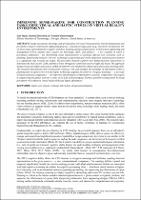Chapter Improving Sense-Making for Construction Planning Tasks Using Visual and Haptic Stimuli in Virtual Reality Environments
| dc.contributor.author | Mutis, Ivan | |
| dc.contributor.author | Oberemok, Marina | |
| dc.contributor.author | Purushotham, Nishanth | |
| dc.date.accessioned | 2024-04-02T15:47:05Z | |
| dc.date.available | 2024-04-02T15:47:05Z | |
| dc.date.issued | 2023 | |
| dc.identifier | ONIX_20240402_9791221502893_87 | |
| dc.identifier.issn | 2704-5846 | |
| dc.identifier.uri | https://library.oapen.org/handle/20.500.12657/89118 | |
| dc.description.abstract | Design documents, drawings, and specifications are visual representations that are fundamental and prevalent in today’s construction engineering practice. Construction specialties (e.g., structural, mechanical) rely on these visual representations to express and draw meaning during collaborations. Construction engineering and management (CEM) students must acquire the knowledge, skills, and abilities — a key example of which is perceptual competence —for interpreting visual representations to facilitate efficient task execution, such as planning. Empowering learners with new technology using robust real-world immersion and interactive features is a significant step towards this target. The presented research explores new human-machine interactions to determine the best way for CEM students to learn through the combined senses of sight and touch. The approach merges visual and haptic interactions within an immersive environment to enhance perception and reasoning skills. The research demonstrates how CEM learners interact with and interpret the meanings of information within a planning task. It explores how VR and haptic technology augment the ability to recognize meanings — a new type of representational competency — for improved interpretation of information related to components with respect to engineering disciplines and sub-systems in a CEM, and investigates learners’ problem-solving ability by using perception-rich enhanced virtual reality (VR) and haptic affordances | |
| dc.language | English | |
| dc.relation.ispartofseries | Proceedings e report | |
| dc.subject.classification | thema EDItEUR::U Computing and Information Technology | |
| dc.subject.other | haptic cues | |
| dc.subject.other | human-computer-interaction | |
| dc.subject.other | design interpretations | |
| dc.title | Chapter Improving Sense-Making for Construction Planning Tasks Using Visual and Haptic Stimuli in Virtual Reality Environments | |
| dc.type | chapter | |
| oapen.identifier.doi | 10.36253/979-12-215-0289-3.14 | |
| oapen.relation.isPublishedBy | bf65d21a-78e5-4ba2-983a-dbfa90962870 | |
| oapen.relation.isbn | 9791221502893 | |
| oapen.series.number | 137 | |
| oapen.pages | 13 | |
| oapen.place.publication | Florence |

